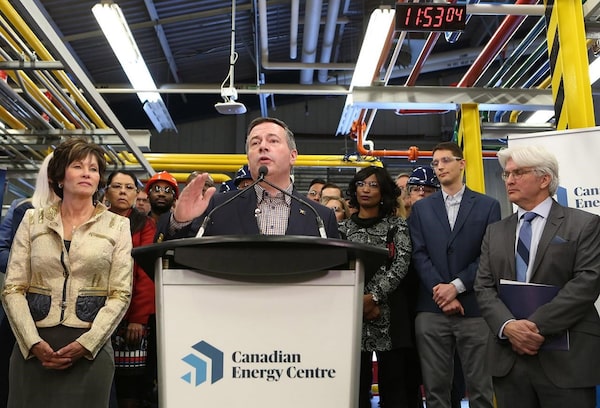
Alberta Premier Jason Kenney, centre, addresses attendees at a press conference to announce the launch of the Canadian Energy Centre at SAIT in Calgary, Alberta Wednesday, December 11, 2019. The CEC provided a whole host of teachable moments during its disastrous first week in December.The Canadian Press
Max Fawcett is a freelance writer and the former editor of Alberta Oil magazine and Vancouver magazine. He previously worked in Alberta’s Climate Change Office.
Alberta’s United Conservative Party government may be cutting funding for education in the province, but its new war room – sorry, “Canadian Energy Centre” – provided a whole host of teachable moments during its disastrous first week in December.
First, chief executive Tom Olsen turned an interview into a PR disaster by telling the reporter that “we are about disproving true facts” – effectively confirming the concerns that have been widely expressed about his organization’s real mission.
But Mr. Olsen’s Freudian slip was soon pushed aside by news that the centre’s logo was identical to one that already belonged to a Boston tech company (called, somewhat ironically, Progress Software). The organization took more than a day to remove the offending logo, and longer still to replace it with a new one – which just so happened to bear a striking resemblance to another company’s brand. So much for the “rapid-response” unit and “swift responses to misinformation spread through social media” that it had promised Albertans.
There are plenty of lessons here for PR agencies and government officials, but the most important one is reserved for those working in the energy sector – the people whose interests the war room was ostensibly created to protect: If you want something done right here, you’ll need to do it yourself.
So far, the centre’s public interventions have, among other things, managed to trigger a spike in subscriptions to a Medicine Hat newspaper that had the temerity to publish a column critical of its efforts. If it’s getting blowback in a place that’s nicknamed “the Gas City,” how is it going to change hearts and minds in communities that aren’t inextricably linked with the extraction of fossil fuels?
Even the people who have been targeted seem more embarrassed by the centre’s work than afraid of it. Steven Lee, an environmental activist behind a youth-oriented climate education campaign called the 3% Project, says the centre’s treatment of him doesn’t exactly back up their claim that they need to shield their tactics from public scrutiny. “Most of them were very common tactics that people use against climate-change messaging,” he told The Canadian Press. “I found it slightly surprising and disappointing that [for] a $30-million war room, all they could pull off was the normal messaging everyone else already does.”
Rather than spending $120-million over the next four years trying to persuade people that the facts they have about Alberta’s energy sector are incorrect, the Alberta government could instead be using that money to actually improve the facts they have. By supporting research into technologies that will help reduce emissions (as the previous government did), Alberta could invest in the best asset its energy sector has right now: its innovators. If the province is going to maximize the value of its resources going forward, innovation will have to play an even bigger role in Alberta’s energy story going forward. In a low-carbon economy, having the biggest reserves in the world will be far less important than having the biggest ideas.
But industry also has to do its part here – and that means not depending on government to tell its story, which is neither as bad as its critics claim nor as good as its boosters want to believe.
It has come a long way from the days when Canadian company Talisman Energy released a colouring book that featured “Talisman Terry, the friendly Fracosaurus," which worked to spread the good news about fossil fuels to children who lived in counties along the Pennsylvania/New York border where Talisman just happened to be operating. But it still tends to gravitate toward arguments that sound an awful lot like Ezra Levant’s Ethical Oil – a narrative that only works in places where people already support oil and gas.
More importantly, it needs to start putting more of its money where its collective mouth is. For all the talk about a sinister campaign using U.S. money to target Canadian oil and gas resources over the past decade, the facts suggest that industry is more Goliath than David here.
As Sandy Garossino noted in the National Observer, approximately $40-million has flowed from U.S. charities and non-governmental funders to the Tar Sands Campaign since 2009. That’s just 1 per cent of the approximately $5-billion that’s been dedicated worldwide to climate initiatives, and a figure that represents a rounding error on the combined operating profits that Canada’s 10 largest oil and gas companies have posted over that same period.
The industry needs to stop playing the victim and start telling a more compelling story about the role it can play in a lower-carbon economy, and that is going to require more substantial investments of capital and courage than it’s made to date, and ones that go beyond things like, say, wearing T-shirts that proclaim one’s affection for the oil sands. But the alternative is letting others do it instead. And as it has seen with the war room so far, that could end up costing it more than just money.
Keep your Opinions sharp and informed. Get the Opinion newsletter. Sign up today.